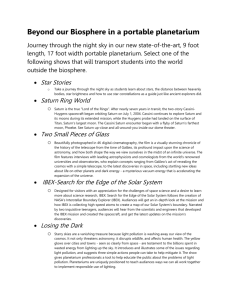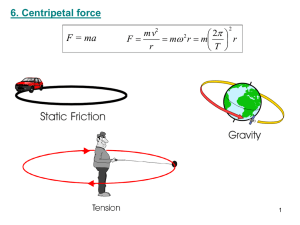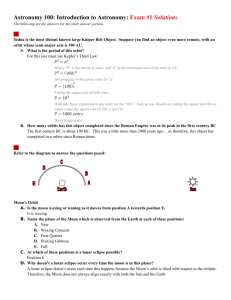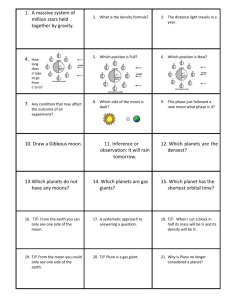Teaching Science Vocabulary with The Shape of a Moon's Orbit
advertisement
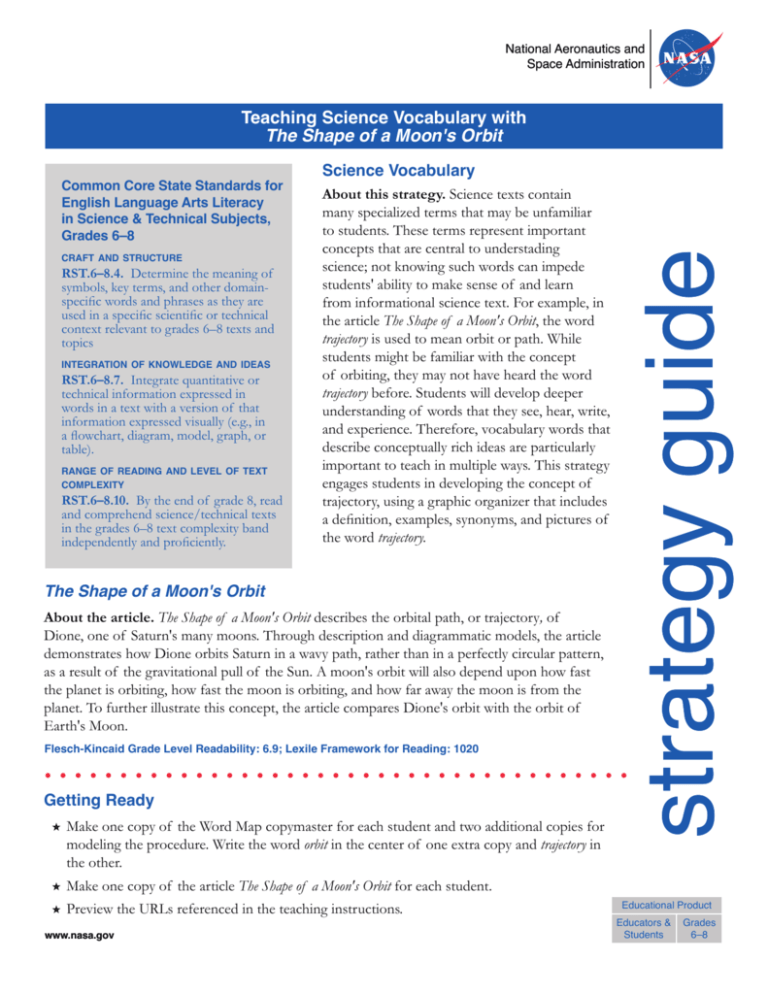
National Aeronautics and Space Administration Teaching Science Vocabulary with The Shape of a Moon's Orbit craft and structure RST.6–8.4. Determine the meaning of symbols, key terms, and other domainspecific words and phrases as they are used in a specific scientific or technical context relevant to grades 6–8 texts and topics integration of knowledge and ideas RST.6–8.7. Integrate quantitative or technical information expressed in words in a text with a version of that information expressed visually (e.g., in a flowchart, diagram, model, graph, or table). range of reading and level of text complexity RST.6–8.10. By the end of grade 8, read and comprehend science/technical texts in the grades 6–8 text complexity band independently and proficiently. Science Vocabulary About this strategy. Science texts contain many specialized terms that may be unfamiliar to students. These terms represent important concepts that are central to understading science; not knowing such words can impede students' ability to make sense of and learn from informational science text. For example, in the article The Shape of a Moon's Orbit, the word trajectory is used to mean orbit or path. While students might be familiar with the concept of orbiting, they may not have heard the word trajectory before. Students will develop deeper understanding of words that they see, hear, write, and experience. Therefore, vocabulary words that describe conceptually rich ideas are particularly important to teach in multiple ways. This strategy engages students in developing the concept of trajectory, using a graphic organizer that includes a definition, examples, synonyms, and pictures of the word trajectory. The Shape of a Moon's Orbit About the article. The Shape of a Moon's Orbit describes the orbital path, or trajectory, of Dione, one of Saturn's many moons. Through description and diagrammatic models, the article demonstrates how Dione orbits Saturn in a wavy path, rather than in a perfectly circular pattern, as a result of the gravitational pull of the Sun. A moon's orbit will also depend upon how fast the planet is orbiting, how fast the moon is orbiting, and how far away the moon is from the planet. To further illustrate this concept, the article compares Dione's orbit with the orbit of Earth's Moon. Flesch-Kincaid Grade Level Readability: 6.9; Lexile Framework for Reading: 1020 Getting Ready ★★ Make one copy of the Word Map copymaster for each student and two additional copies for modeling the procedure. Write the word orbit in the center of one extra copy and trajectory in the other. strategy guide Common Core State Standards for English Language Arts Literacy in Science & Technical Subjects, Grades 6–8 ★★ Make one copy of the article The Shape of a Moon's Orbit for each student. ★★ Preview the URLs referenced in the teaching instructions. www.nasa.gov Educational Product Educators & Students Grades 6–8 Disciplinary Literacy in Science Literacy is an integral part of science. Practicing scientists use reading, writing, and oral communication to explain their findings, conduct research, connect to the work of other scientists, and communicate ideas to a variety of audiences. Situating literacy instruction in a content area, such as science, has several benefits. First, it helps students develop ways of thinking that are characteristic to the discipline. By building background knowledge, science also helps students access high-level content in text that often can be difficult to grasp. Finally, science provides an authentic reason for reading—to better understand the science ideas under study. Reading, like science, can be an act of inquiry when there are genuine questions to be investigated. AAAS Benchmarks for Scientific Literacy ★ 1B/P3 Describing things as accurately as possible is important in science because it enables people to compare their observations with those of others. ★ 4G/M2 The Sun's gravitational pull holds Earth and other planets in their orbits, just as the planets' gravitational pull keeps their moons in orbit around them. ★11B/E2 Geometric figures, number sequences, graphs, diagrams, sketches, number lines, maps, and oral and written descriptions can be used to represent objects, events, and processes in the real world. ★ 411D/M3 Natural phenomena often involve sizes, durations, and speeds that are extremely small or extremely large. These phenomena may be difficult to appreciate because they involve magnitudes far outside human experience. ★ 12A/H4 Scientists value evidence that can be verified, hypotheses that can be tested, and theories that can be used to make predictions. Teaching Science Vocabulary with The Shape of a Moon's Orbit Activate and Build Background Knowledge 1. On the board, write the following guiding question: "Do the moons of all planets orbit in the same way?" 2. Pose the guiding question and invite students to turn to a neighbor to talk about their ideas. 3. Project the Word Map copymaster with the word orbit in the center. Explain that a word map is a tool for organizing information about important ideas in science text. Elicit student definitions of the word orbit and record them in the Definition box on the copymaster. 4. Ask students what orbiting typically looks like (e.g., a circular path). In the Picture box on the copymaster, sketch a simple diagram of one object orbiting another. 5. Continue modeling how to complete the rest of the word map, discussing students' ideas along the way. For instance, prompt students to come up with examples of the word orbit (e.g., the Moon orbits Earth, Earth orbits the Sun) or to think of synonyms for the word orbit (e.g., course, path, circuit, track, revolution, circle). Set Purpose for Reading 1. Ask students if they think there are any instances when the orbit of a planet or a moon doesn't look like a circle. Prompt students to explain their thinking. 2. Introduce the article The Shape of a Moon's Orbit and tell students it compares the movement of one of Saturn's moons, Dione, to Earth's Moon. 3. Distribute one copy of the Word Map copymaster to each student. Project the copymaster with the word trajectory in the center. Read the word aloud and explain that this word is used in the article as a synonym for the word orbit. Explain that after students read, they will record information in each section of the word map. 4. Distribute copies of the article and prompt students to read the text alone or with a partner. Direct students to highlight, underline, or annotate places in the text that help deepen their understanding of the word trajectory. 5. After students have finished reading, invite them to share ideas for the word trajectory that they recorded in each section of their word maps. You may want to record these on another projected copy of the word map. Teaching Science Vocabulary with The Shape of a Moon's Orbit (continued) Additional Support for Students with Dyslexia ★ Modify reading materials. Integrate Text and Experience 1. Project an image of Dione and Saturn, found at http://www. nasa.gov/multimedia/imagegallery/image_feature_242.html. Discuss the relative difference in size between the moon Dione and the planet Saturn. Elicit ideas about how size might affect the orbit of this moon around Saturn. 2. Focus students' attention on the visual representations on each page of the article. First, discuss the diagram on the first page and invite students to describe what the diagram shows or whether they notice anything that is confusing. Next, discuss the diagram on the second page. Compare it to the diagram on the first page. 3. Ask students to think about why the diagrams were included in the text. Discuss how images and visual representations enhance students' understanding of the concept. Invite students to add more notes to their word maps. Apply New Ideas 1. Return to the guiding question Do the moons of all planets orbit in the same way? Discuss the similarities and differences between the orbits of Dione and Earth's Moon. 2. Project the image of Dione with a few of Saturn's other moons, found at http://www.nasa.gov/mission_pages/cassini/ multimedia/cassini20080219.html. Elicit predictions about how Hyperion, Epimetheus, and Lapetus orbit around Saturn. Remind students to cite evidence for their responses. 3. See below for additional or updated NASA resources. The student articles and copymasters are available in the Dyslexie font, a typeface developed to help individuals with dyslexia read more fluently. For more information, see http://www. studiostudio.nl/. ★ Provide explicit instruction. Define terms using NASA's online Picture Dictionary: http://www.nasa.gov/ audience/forstudents/k-4/dictionary/ index.html. ★ Enhance information processing. Prepare a graphic organizer such as a Venn diagram to record information as you compare and contrast Dione and Earth's Moon. Demonstrate how to record similarities in the center of two overlapping circles and differences in the outer edges. Have students work in groups to reread the article to find more information to record. ★ Engage another learning modality. Act out the orbital path of Saturn's moon Dione. Have students form groups of four. While one student reads aloud the description in the second paragraph of the article, the other three students try to model the orbital paths of Saturn and Dione around the Sun. ★ Allow independent exploration. Set up a support computer with Internet access Additional for these reading strategy guides comes froma NASA's Interstellar Boundary to the Shoot Cannonball into Orbit Explorer (IBEX) Education and Public Outreach activity: http://spaceplace.nasa.gov/ Program, http://www.ibex.swri.edu. how-orbits-work/. Allow students to experiment with the simulator and compare the trajectories of cannonballs launched with different amounts of gunpowder. NASA Resources Moons of Saturn Lithograph: http://www.nasa.gov/pdf/145739main_Moons.of.Saturn.Lithograph.h.pdf Quintet of Moons Image: http://www.nasa.gov/mission_pages/cassini/multimedia/pia14573.html A Pair of Saturn's Moons Image: http://www.nasa.gov/multimedia/imagegallery/image_feature_ 2318.html About the Cassini Mission: http://saturn.jpl.nasa.gov/science/index.cfm Postcards from Saturn Video Podcast: http://www.nasa.gov/mp3/330046main_ARC-Kepler-Podcast-Seg6.mp3 Name ___________________________________________ Date _________________ Word Map Title of article: Definition Example Picture Synonym © 2012 The Regents of the University of California Permission granted to purchaser to photocopy for classroom use. When is a circle not a circle? Many objects in the Solar System move in orbits that are very circular. For instance, Dione is a moon that moves around the planet Saturn in an orbit that is almost a perfect circle. It seems perfectly logical to say that the trajectory of Dione is circular. But is it really? While Dione is circling around Saturn, Saturn is not sitting still. Saturn is moving around the Sun. The gravitational pull of the Sun affects Saturn and all its moons, so they all move around the Sun together. Saturn moves in an orbit that is almost a perfect circle, but what kind of trajectory does a moon such as Dione follow? The path of a moon around the Sun can be quite complicated. It depends on how fast the planet is moving, how fast the moon is orbiting, and how far away the moon is from the planet. Dione moves around the Sun in a wavy path that makes a little loop every time it orbits around Saturn. Every time Saturn orbits the Sun once, Dione orbits Saturn about 3,931 times, so the trajectory that Dione follows is an intricate path with thousands of waves and loops. Sun Permission granted to photocopy for classroom use. The Shape of a Moonʼs Orbit Dione, a moon of Saturn, photographed by the Cassini spacecraft in December 2005. orbit of Saturn path of Saturn path of Dione © 2012 The Regents of the University of California The bottom part of the diagram is a close-up of a very small part of Saturn᾽s orbit around the Sun. You can see the moon Dione᾽s trajectory as it orbits Saturn. Permission granted to photocopy for classroom use. Earth’s Moon is like Dione in some ways and different in other ways. Our Moon orbits Earth in very much the same way that Dione orbits Saturn. The orbits are even about the same size. What is different are the speeds. Earth orbits the Sun much more quickly than Saturn does, and the Moon orbits Earth much more slowly than Dione orbits Saturn. While Dione orbits Saturn thousands of times on each orbit around the Sun, the Moon orbits Earth only about a dozen times. Earth’s Moon does follow a slightly wavy path around the Sun, but the waves are very stretched out and do not have loops in them. Earth's moon photographed by the Galileo spacecraft in December 1992. motion of Earth motion of the Moon © 2012 The Regents of the University of California This diagram is exaggerated. It makes the path of the Moon around the Sun look wavier than it really is. If the diagram were more accurate, you wouldn’t be able to tell that the Moon’s path around the Sun is wavy at all! Sun All photographic images courtesy of NASA.


